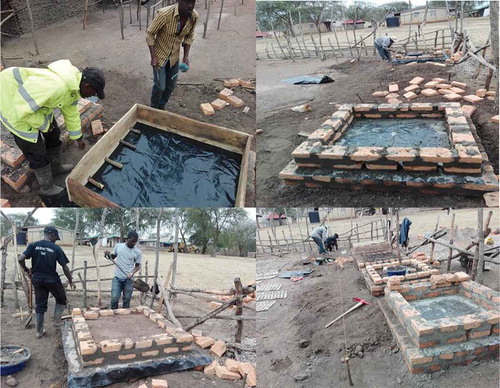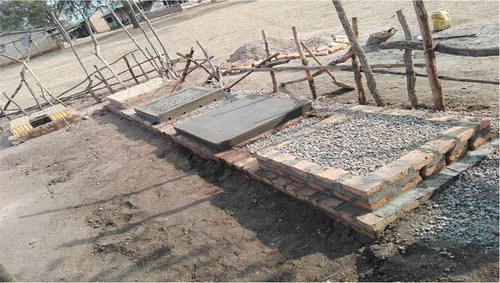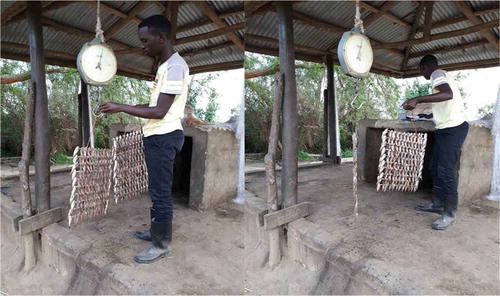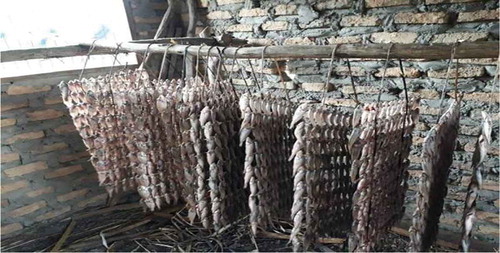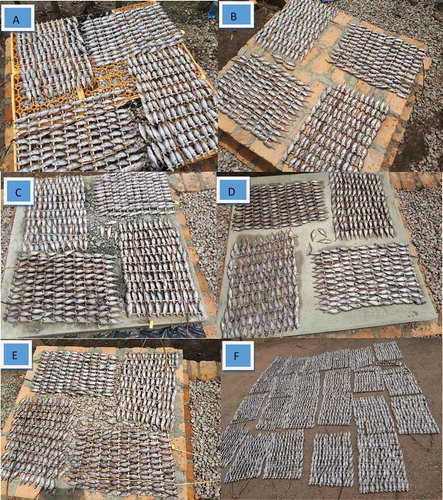 ?Mathematical formulae have been encoded as MathML and are displayed in this HTML version using MathJax in order to improve their display. Uncheck the box to turn MathJax off. This feature requires Javascript. Click on a formula to zoom.
?Mathematical formulae have been encoded as MathML and are displayed in this HTML version using MathJax in order to improve their display. Uncheck the box to turn MathJax off. This feature requires Javascript. Click on a formula to zoom.Abstract
Uganda has been exporting fish to the European Union and the United States since 1992, but occasionally faces bans on fish exports whenever it fails to process fish to international standards. This study compared the efficiency and quality of the currently used traditional “Bare ground” (BG) fish drying method to five newly constructed surfaces in drying Haplochromis sp. Five surfaces; Plastic palette fabric (PPF), Burnt clay brick (BCB), Popcorn concrete (PC), Screened concrete (SC) and Mass concrete (MC) were constructed within 7 days. Altogether, 24 racks of Haplochromines were used in the comparative study. Slight but insignificant (p > 0.05) differences in moisture loss were observed after day 3 of drying. Comparison of the drying surfaces based on microbial counts revealed considerable reduction in Total Plate Counts (TPC), Escherichia coli, and Staphylococcus aureus. The TPC (cfu/ml) of microbes reduced most on PPF from 2.3 × 108 before drying to 6.0 × 107 after drying, followed by MC from 1.5 × 108 to 6.0 × 107 and PC from 1.0 × 108 to 2.0 × 107. The TPC however increaed significantly on BG from 1.8 × 108 to 4.0 × 108. The S. aureus counts only reduced on BCB, PPF, and PC, but increased on “BG”, SC, and MC. When fish body shape after drying was considered, BG emerged as the best drying surface producing the least curved fish. Although all the drying surfaces were equally efficient, BG had a worrying increase in TPC and S. aureus, implying PPF or MC could substitute its use to produce better quality fish.
Keywords:
PUBLIC INTEREST STATEMENT
The preservation of foodstuff by removing excess water through drying extends the quality and storage life of the product. Sun drying of fish, especially on the ground is a common practice of many local fisher folk communities in Africa. If properly dried and stored, the fish can last 6-12 months. We compared multiple surfaces (plastic palette fabric, mass concrete, burnt clay brick, popcorn concrete, screened concrete, and bare ground) for their ability to dry fish. Results indicated the bare ground, dried fish slightly better, although the other surfaces were better in terms of holistic hygiene, and probably longevity (shelf-life). Properly dried and stored fish provides a value-added product that could possibly enter the regional and international market without spoilage. Given the popularity of fish in human diets, further work in this area needs to be done for economic and public health reasons.
Competing Interests
The authors declares no competing interests.
1. Introduction
Fish being a major source of protein around the world, its harvesting and processing methods must be done in ways that enable efficient market distribution to provide livelihood for millions of people (Al-Jufaili & Opara, Citation2006; Laique & Karim, Citation2015; Numbing & Maikasuwa, Citation2015). Fisheries is one of the most significant renewable resources that Uganda and East Africa are privileged to have for food security, livelihood and economic growth. Fish and fisheries provide a major livelihood for the Ugandan people, providing vital roles in generating employment, nutrition, earning foreign currency and other aspects of the economy (FAO, Citation2017; Oenga, Mwanja, & Mushi, Citation2005; Ssempijja, Citation2017). The processing methods of freshwater fish should assure palatability, the best market quality, health safety, and reduce waste to the best possible extent. Fish traders prefer the best-looking fish in terms of its normal size, shape, and the quality (extent) of its processed form. Therefore, the use of appropriately designed processing technology is the best approach to stem up fish production and consumption (Al-Jufaili & Opara, Citation2006).
The different methods of fish processing include drying, salting, freezing, smoking, curing, dehydration, pickling, cooking, canning, and fermentation, among others (Gawi & Sogbesan, Citation2017; Kallon, Lebbie, Sturm, Garnett, & Wadsworth, Citation2017; Laique & Karim, Citation2015). Most fish capturing sites are situated in areas far-off from the market places and final consumers, therefore, the risks of fish decomposition and the uncertainties of their sale in markets are high. Fish processing is a very important part of both small scale and commercial fisheries because efficient processing keeps the fish fresh for a long time, with a minimum loss of taste, odor, flavour, nutritive value and the digestibility (Darvishi, Azadbakht, Rezaeiasl, & Farhang, Citation2013).
Freshwater fish caught from landing sites within and around protected areas in Uganda are mainly preserved by drying, smoking, and freezing, before being transported to far-off markets for sale. A good number of freshwater fish catches in Uganda are marketed as dried products. Tilapia (Tilapia zili), Lung fish (Propterus spp), Cat fish (Clarias spp), Mud fish (Neachana spp), “Enkejje” (Haplochromine sp) and Mukene (Silverfish) caught from many lakes in Uganda are always first sundried on bare ground, racks, banana leaves, iron sheets or other kinds local materials for two-three days to make them well preserved and worthy for the market. The problem however is that these dried fish products are not often dried hygienically and in an aesthetic manner that allows good marketability; for instance, those dried on bare ground, have dust and sand content high (Basu, Khasim, & Srinivasa, Citation1987), with probable disposition to microbial invasion.
In order to reduce the contamination to improve the overall hygienic condition of the dried fish, our work compared the efficiency of five different fish drying surfaces, namely; Plastic palette fabric, Burnt clay brick, Popcorn concrete, Screened concrete, Refined stone, and Bare ground (Maraam).
2. Methods
2.1. Ethical approval
Before commencement of the project, research approval was sought from Uganda Wildlife Authority (UWA) Ref No. UWA/COD/96/05). Consent was also sought from community leaders and an inquiry into the communities’ social and economic profile was made.
3. Construction of the surfaces
Five new surfaces, namely; Plastic palette fabric (PPF), Burnt clay brick (BCB), Popcorn concrete (PC), Mass concrete (MC) and Screened concrete (SC) were constructed within a period of 7 days (Figures &).
4. Quality and safety assessment of the fish
This was done by assessing the moisture, curvature of the fish and microbial content. To assess moisture content certain biometric measures had to be carried out first.
4.1. Biometrics
The experimental fish (Haplochromis sp) were fixed on the mats by the women who were engaged in the sun drying processing method. The fish mats with fresh fish were then weighed (Figure ) and later the initial moisture content determined and the drying process started.
4.2. Moisture content measurement and drying of the fish
The fish were hanged (Figure ) for one day to allow water to drip off. On day two, the fish were then displayed on all the surfaces to dry under the sun (Figure ). The fish were left on the drying surfaces from 8 am to 6 am after which they were collected and stored in a cool dry place in the house. The drying was repeated one last time on day three. Measurements for percentage moisture loss were done 3 times daily. Average percentage moisture lost was calculated by the formulae:
4.3. Curvature
The appearance of fish’s shape was graded by how many of the dried fish curved, especially at the tail end. Curving usually occurs when there is too much heat on one side of the fish (uneven heat distribution). Curved fish were not considered good for the market. On all the drying surfaces, the number of curved fish were counted and recorded.
5. Sample collection for microbiology
It is very important to perform a microbiological analysis of the fish dried from the different surfaces so as to determine which of the drying surfaces gives a product free of pathogenic bacteria that are of public health significance. The presence of bacteria harmful to man is an indication of poor sanitation in fish handling and processing. The contamination during sun drying at the landing site is either of human or animal origin. It can be from bird droppings, animal excreta or contact (from monkeys and baboons). Sun dried fish are known to have high rates of salmonella contamination. The purpose of carrying out the microbiological tests is to detect pathogenic bacteria (Salmonella, Staphylococcus aureus, E. coli) or indicator organisms of faecal pollution.
Fish samples were collected each day and stored in sterile containers containing Stuart’s transport media. The samples were immediately taken to the Microbiology Laboratory at the College of Veterinary Medicine, Animal Resources and Biosecurity (CoVAB) for Laboratory analysis.
6. Laboratory procedures
Swabs were made from all the fish racks respective of the drying surfaces they were placed. First swabs were made immediately the fish racks were washed and labelled, before being put in the storage house for the water to drip off. Second swabs were also obtained after final day of drying from the respective mats so as to be able to compare their microbial content before and after drying. All the collected swabs were placed in transport media and stored in a cooling box at 4 Degrees Celsius.
The samples were immediately transported to the laboratory for analysis because transport media can only enable the microbes remain viable for not more than a week. When in the laboratory, the swabs were removed from transport media and placed in peptone water and vortexed so as to dissolve the microbes into the diluent.
7. Enumeration of salmonella
Xylose Lysine Deoxycholate agar (XLD agar), a selective growth medium, was used in the isolation of Salmonella (Aryal, Citation2018; Park, Ryu, & Kang, Citation2012). Rappaport was used as an enrichment media for salmonella. First, the prepared Rappaport media was heated to dissolve particles, then 9mls was dispensed into each test-tube which was plugged with cotton on top. The XLD media was heated to boiling point, then cooled to about 45°C. Twenty milliliters of XLD media was cast into each plate and left to solidify, after which incubation was continued at 37°C. This was followed by checking for sterility by observing for green or black colonies with or without metallic sheen, and pink colonies with dark centers to rule out contamination. Only uncontaminated plates were surface spread by streaking with the different serial dilutions of the respective surface drying samples (ten-fold serial dilutions in 1% peptone water and plated out on the culture media). All the plates were incubated at 37°C for 24 hours and examined for red slant and yellow butt colonies with black spots which were expressed as colony forming units per gram of fish muscle (Cfu ml-1) of the representative samples.
8. Enumeration of Staphylococcus
Mannitol salt agar (MSA), a selective media for staphylococcus, containing high concentration of sodium chloride was used. It is selective for the gram-positive Staphylococcus aureus. Staphylococcus aureus ferments mannitol and the pH indicator phenol red in the agar turns yellow (a pH indictor for detecting acid produced by mannitol fermenting S. aureus (Haaber, Cohn, Petersen, & Ingmer, Citation2016). The 116.7 gm of MSA medium was combined with 1 l of deionized water and stirred to mix thoroughly. The mixture was boiled to dissolve completely with caution not to overheat. The mixture was then autoclaved at 121°C for 15 min. Twenty milliliters were then cast into each plate, left to set and incubated overnight at 37°C to check for sterility. Only plates without yellow colonies were surface spread with 1 ml of serial dilutions of 1:100, 1:1000 and 1:10,000. After the plates were incubated at 37°C for 24–48-h yellow block colonies surrounded by a clear zone were counted and expressed as colony forming units.
9. Enumeration of E. coli
Escherichia coli was identified using a selective media. About 26.6 gm of Violet Red Bile Agar (VRBA) was suspended in 1 l of distilled water and mixed thoroughly. The solution was heated to boiling point to dissolve the agar components. The media was cooled to around 45°C, and 20mls were cast into each plate and left to set. Thereafter, the plates were incubated overnight to check sterility. Only uncontaminated plates were surface spread for serial dilutions of 1:100, 1:1000 and 1:10,000 for samples A1-F1 and A2-F2. Pink colonies (due to sugar fermentation) were counted and expressed as colony forming units.
10. Standard plate count (Total Plate Count)
The Plate count agar (PCA), a basic media that supports growth of any organism whether in aerobic or anaerobic conditions was used for the heterotrophic bacterial plate count (Scharlau, Citation2011). About 116.7 gm of PCA media was combined with 1 l of deionized water then stirred to mix thoroughly. The mixture was boiled to dissolve completely with caution to overheat. The mixture was then autoclaved at 121°C for 15 min. Twenty milliliters were then cast into each plate, left to set and incubated overnight at 37°C to check for sterility. Only plates without contamination were point inoculated with 10 µl of serial dilutions of 1:100, 1:1000 and 1:10,000. The plates were then incubated at 37°C for 24–48 h. After incubation, all colonies were counted and expressed as colony-forming units.
11. Results
11.1. Surface drying efficiency based on days of drying
The percentage mean moisture loss based on period of drying on different surfaces in presented in Table . On day three, the mean moisture loss was highest on Popcorn concrete, followed by Screened concrete, Burnt clay brick, Mass concrete, Bare ground, and lastly Plastic palette fabric.
Table 1. Surface drying efficiency (Percentage moisture loss) based on period of drying
12. Surface drying efficiency based on microbial content
The surface drying efficiency based on microbial content is presented in Table . It represents the microbial counts before and after drying, on the different surfaces. The Comparison revealed considerable reduction in Total Plate Counts (TPC), Escherichia coli, and Staphylococcus aureus. The TPC (cfu/ml) of microbes reduced most on Plastic palette fabric from 2.3 × 108 before drying to 6.0 × 107 after drying. This was followed by Mass concrete and Popcorn concrete. The TPC, however, increased significantly on “Bare ground”.
Table 2. Surface drying efficiency based on microbial counts
The S. aureus counts (cfu/ml)) only reduced on Burnt clay brick, Plastic palette fabric, and Popcorn concrete, but increased on “Bare ground”, Screened concrete, and Mass concrete. Escherichia coli was completely eliminated after drying on all surfaces and no Salmonella organisms were detected in all the samples.
13. Curvature or bending after drying
When fish body shape (remaining straight or bending, especially at the tail end) after drying was used as another parameter to assess fish quality after drying, “Bare ground” emerged as the best drying surface producing the least curved/bent fish, followed by Popcorn concrete, Mass concrete, Burnt clay brick, Screened concrete and Plastic palette fabric (Figure ).
14. Discussion
Uganda exports fish and fish products, but occasionally faces bans on exports whenever it fails to process fish to international standard. International hygiene and processing quality standards for fish exports dictate that fish is of a certain quality before it is considered for export. Even on the local and regional markets, there are certain set standards that dictate product marketability; for instance, there is increased demand for fish that is well dried, and can stay for a while before it gets spoiled. All fresh fish contain up to more than 80% of water and is highly perishable, having a short storage life (Darvishi et al., Citation2013). Knowing this, local people have tried to devise surfaces that are appropriate for drying fish in order to preserve it. The most commonly used one, especially for the haplochromines is the bare ground technique (Basu et al., Citation1987), which although used by many fisherfolk in Uganda, has not been scientifically compared with others to prove its drying efficiency. The fact that fish is dried on bare ground leaves a lot of questions regarding hygiene. It is therefore based on this background that a study on drying kinetics of fish using Haplochromis sp. was necessary. In the present study, the drying efficiency based on period, microbial content and fish body shape were considered. This is the first study exploring the efficiency of innovatively designed drying surfaces, namely; Plastic palette fabric, Burnt clay brick, Popcorn concrete, Screened concrete, and Mass concrete.
After all the considerations, there was no significant difference (p > 0.05) in the efficiency of the drying surfaces based on period of drying. Several studies on fish drying surfaces have been done comparing different solid surfaces (Basu et al., Citation1987; Gawi & Sogbesan, Citation2017; Kallon et al., Citation2017; Laique & Karim, Citation2015; Numbing & Maikasuwa, Citation2015), microwaves, solar dryers, and other materials (Al-Jufaili & Opara, Citation2006; Gawi & Sogbesan, Citation2017). Although most of the studies that compared solid surface drying efficiency based on moisture loss also reported no significant differences, the choice of the appropriate surface was determined by other factors such as easy availability of raw materials, and acceptance by the community. Furthermore, the choice of the best drying surfaces could also be determined by the level of microbial contamination following the drying process. A good drying surface should be able to dry the fish as well as reduce the number of microbes to cater for safe consumption of the product. The present study identifies the Plastic palette fabric, Mass concrete and Popcorn concrete as surfaces that showed significant reduction in total bacterial plate count after the drying process. There are no previous studies to compare these findings, but this could be because our surfaces were designed to cater for efficient water drainage, were clean, and were high enough from the ground to avoid contamination by soil, following rainfall, compared to the other surfaces. This means that after the rain, when the fish were laid on the surfaces again, those that had poor water drainage dried the fish at a slower rate and were prone to contamination.
The bare ground surface is preferred by the community simply because it dries the fish fast and they remain in what they call “perfect shape”, without bending. However, their choice is not really based on comparison with any other drying surfaces. The bare ground may be effective in drying but is a hub for very many microbes, the reason it had a significant number of total bacterial count (4.0 x 108) and S. aureus (2.5 x 108) on day 3 of drying. Bare ground is a hub to a multitude of micro-organisms, some of which are harmful to humans. Fish dried on bare ground surface is highly exposed to harmful bacteria found within soil that can cause potential harm to humans (Basu et al., Citation1987). Some forms of bacteria can produce poisonous toxins, which can be fatal if the spores of such bacteria are inhaled, ingested or transferred through an open wound. It is therefore imperative that the local community is sensitized and advised to adopt another form of fish drying surface (either plastic palette fabric or mass concrete) to produce more quality fish. The adoption of a new more efficient surface may take a while, but the local communities’ being aware that there are improved fish drying methods that they could consider, is a positive impact towards food safety.
15. Limitations
Unforeseen weather changes; disruption of the drying process by rainfall, and limited funds to include other (traditional) fish drying methods in the comparative study.
Conflict of interest
The authors confirm that there was no conflict of interest.
Acknowledgment
The authors are indebted to the Department of International Studies, Mississippi State University, for providing the funds to conduct this study. Thanks also go to the Rubare fishing community at Lake Mburo for accepting to be part of the study and providing the necessary information.
Additional information
Funding
Notes on contributors
Celsus Sente
Celsus Sente (BVM, MSc., Ph.D.) is Lecturer, veterinarian, environmental microbiologist and conservation medicine specialist. He has a keen interest in biotech innovations.
Margaret Khaitsa
Margaret Loy Khaitsa (BVM, MSc., Ph.D.) is a Professor of epidemiology (with an international emphasis). She is instrumental in the international annual summer school rotations for American and East African students. She is involved in partnerships for innovative solutions for sustainable development.
Joseph Tomusange
Joseph Tomusange (BBLT) is a student of Master of Science in International Infectious Diseases (IDM).
Howard Onyuth
Howard Onyuth (B.WHM) is a research vendor. He is interested in behavioural ecology, molecular epidemiology, conservation and research innovations.
David Kahwa
David Kahwa (BSc., MSc., Ph.D.) is a Lecturer and a specialist in aquaculture management and precision farming.
Hartford Bailey
Hartford Bailey is a Professsor with special interest in research (pre-and post-harvest food safety), teaching and service.
References
- Al-Jufaili, M. S., & Opara, L. U. (2006). Status of fisheries postharvest industry in the Sultanate of Oman: Part 1-handling and marketing systems for fresh fish. Journal of Fisheries International, 1(2), 144–11.
- Aryal, S. (2018). Xylose lysine deoxycholate (XLD) agar- principle, uses, composition, preparation and colony characteristics. Retrieved from https://microbiologyinfo.com/xylose-lysine-deoxycholate-xld-agar-principle-uses-composition-preparation-and-colony-characteristics/
- Basu, S., Khasim, D. I., & Srinivasa R. P. (1987). Comparative Efficiency of Different Surfaces for Drying Fish, 24(1), 37–40.
- Darvishi, H., Azadbakht, M., Rezaeiasl, A., & Farhang, A. (2013). Drying characteristics of sardine fish dried with microwave heating. Journal of the Saudi Society of Agricultural Sciences, 2013(12), 121–127. doi:10.1016/j.jssas.2012.09.002
- FAO. (2017). National fisheries and aquaculture overview. Uganda: FIGIS Publications.
- Gawi, G. O., & Sogbesan, O. A. (2017). Fish processing and preservation techniques selected fishing communities along the Upper Benue River, Taraba State. Poultry, Fisheries & Wildlife Sciences, 5, 184. doi:10.4172/2375-446X.1000184
- Haaber, J., Cohn, M. T., Petersen, A., & Ingmer, H. (2016). Simple method for correct enumeration of Staphylococcus aureus. Journal of Microbiological Methods, 125, 58–63. doi:10.1016/j.mimet.2016.04.004
- Kallon, A., Lebbie, A., Sturm, B., Garnett, T., & Wadsworth, R. (2017). Comparative studies of fish smoking and solar drying in the Sierra Leone artisanal fishing industry. Journal of Stored Products and Postharvest Research, 8(3), 40–48.
- Laique, M., & Karim, A. (2015). Presentation on fish processing, preservation and trasporting science. UK.
- Numbing, M., & Maikasuwa, G. (2015). Construction of domestic solar fish dryer. Journal of Applied Physics, 7(5), 9–13.
- Oenga, D. N., Mwanja, W. W., & Mushi, V. (2005). Meeting the increasing demand for fish in the Lake Victoria Basin through development of aquaculture. Paper presented at the Lake Victoria Fisheries Organization Conference, Entebbe, Uganda.
- Park, S.-H., Ryu, S., & Kang, D.-H. (2012). Development of an improved selective and differential medium for isolation of Salmonella spp. Journal of Clinical Microbiology, 50(10), 3222–3226. https://www.ncbi.nlm.nih.gov/pmc/articles/PMC3457425/. doi:10.1128/JCM.01228-12 Retrieved from . https://www.ncbi.nlm.nih.gov/pubmed/22814469
- Scharlau. (2011). PLATE COUNT AGAR (PCA). Retrieved from https://www.scharlabmagyarorszag.hu/katalogus/064-BA1005_EN.pdf
- Ssempijja, V. B. (2017). Report to Parliament on Fisheries Management:Uganda Vision 2040. Kampala: National Planning Authority.

